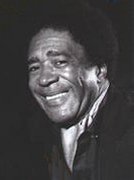 |
Freddie ReddPiano, Composer |
|---|
 |
Freddie ReddPiano, Composer |
|---|
"He has recorded infrequently, but each time Freddie Redd has left a potent mark on the world of jazz."
--Alan Lorber
Since his emergence as composer of the score for Jack Gelber's harrowingly exact play, The Connection, Freddie Redd has finally been gaining some of the recognition that has eluded him for much of his playing career. Freddie also plays the taciturn pianist in the play with convincing effect. Although he hopes to work again in the theatre, Freddie remains essentially a jazz player-writer, and this album underlines his growth as a composer of vigorously expressive jazz originals.
Freddie has been writing since he started playing. In both disciplines, he is largely self-taught. Born in New York, May 29, 1928, Freddie came of a moderately musical family. His mother sang in church, and still does; and his father, who died when Freddie was not yet a year old, had played piano.
Unlike most professional jazzmen, Freddie didn't take up an instrument until quite late in his teens. Around 1946, when he was in the Army, Freddie bagan to pick up the piano on his own. After being discharged, he studied for a month at the Greenwich House Music School in New York, but he bacame so proficient through his own investigations that he left school to take his first professional job, a jazz gig in Syracuse. With him, by the way, was tenor saxophonist Tina Brooks.
After Syracuse, he free-lanced in Harlem, especially in a sit-in room called Club Harlem where pay was small but the chance to learn before an audience and other musicinas was extensive. Meanwhile, he was absorbing a number of influences. The first jazz record he recalls having had a sharp impact on him was the Charlie Parker--Dizzy Gillespie "Shaw' Nuff" to which he was exposed in the Army. Later, Freddie heard Bud Powell. "Bud really got me started. I'd never heard a pianist play quite like that--the remarkably fluent single lines and the pretty chords. In time, Thelonious Monk got to me too. Actually, however, I've been influenced by many things I've heard on a lot of instruments. What I do is try to piece together what stimulates me into my own way of feeling things musically."
By 1953, Freddie had joined Cootie Williams and spent a stimulating year traveling mostly through the South. Back in New York, Freddie started working with vibist Joe Roland and began to be heard quite often at Birdland's informal Monday night sessions. In 1954, Freddie was with Art Blakey, and then for a time he seemed to have disappeared. He turned up in Sweden on a tour with Rolf Ericson, joined Charlie Mingus's Jazz Workshop in 1956, and when Mingus went to the coast, Freddie left the band there. He was based in San Francisco for six months, and returned to New York where he did some recording but was inactive on the club scene.
After several years of shuffling, the chance came to write the music for and appear in The Connection. Freddie has been at the Living Theatre on Sixth Avenue ever since. He doesn't find the long run dull since "something different happens every night," but he would like to form his own group and go back into the clubs. He was particularly anxious to work out some of his ideas on how jazz writing and playing can be productively interrelated in this album and the result, he feels, has given him more confidence than any experience since his scoring The Connection.
--NAT HENTOFF, from the liner notes,
Shades Of Redd, Blue Note.
A selected discography of Freddie Redd albums.
| Find Freddie Redd on Amazon.com | Find Freddie Redd on eBay.com | |
|---|---|---|
| Freddie Redd CDs on Amazon | Freddie Redd CDs & LPs on eBay | |
| The Connection, VHS, 1960 | Freddie Redd DVD / VHS on eBay | |
| Freddie Redd BOOKs on eBay |
 Music |
 Home |
 Musicians |
|---|
|
Any comments, additions or suggestions should be adressed to:
The Hard Bop Homepage / Eric B. Olsen / ebolsen@juno.com |
Other Web Sites: A History of Horror Author Eric B. Olsen |